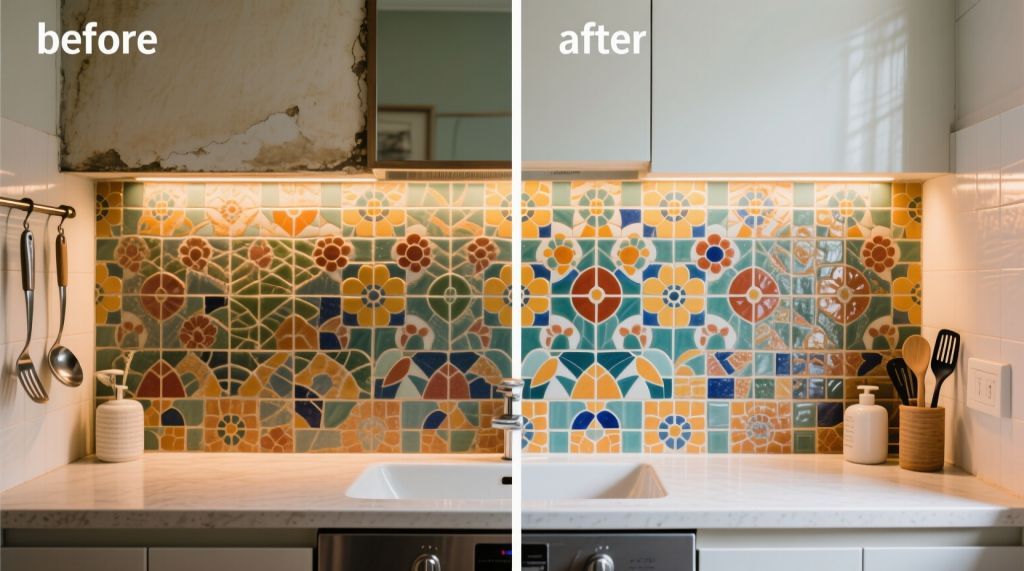
Mosaic tiles can transform any space, adding a burst of color and intricate designs to kitchens, bathrooms, or outdoor areas. However, their charm can lead to unexpected costs if you don’t plan carefully. A small project, like a backsplash, can quickly expand, straining your budget. Here’s a clear, practical guide to budgeting for a mosaic tile renovation that keeps your finances in check.
Clarify Your Project’s Purpose
Start by defining what you want to achieve. Are you adding a mosaic tile accent to a kitchen wall? Redoing a bathroom shower? Or creating a decorative floor for an entryway? The scope of your project directly affects costs. A small feature area requires fewer mosaic tiles than a full-room renovation, so clarity is crucial.
Sketch your vision or save inspiration photos to stay focused. This preparation helps you avoid overspending when you visit a tile shop filled with dazzling options.
Measure Accurately
Calculate your project area’s square footage by measuring length and width. Add 10–15% extra to account for waste, such as tiles broken during cutting or layout mistakes. For complex designs with curves or corners, a 20% buffer is safer.
This number is the foundation of your budget. Buying too few mosaic tiles can stall your project, while overbuying wastes money. Precise measurements ensure you’re ready before shopping at a tile shop.
Understand Tile Pricing
Mosaic tiles are sold in sheets, with prices varying by material. Ceramic tiles are typically the most affordable, while glass, natural stone, or custom designs cost more. For a 50-square-foot project, a $6-per-square-foot tile versus a $22 tile could mean an $800 difference.
When browsing a tile shop, compare prices across materials and set a budget based on your square footage. This keeps you from falling for a tile that’s stunning but too expensive.
Shop Around for Savings
Not all tile shops price mosaic tiles the same. One might offer deals on ceramic, while another has discounts on glass or overstock items. Visit multiple shops, either in person or online, and ask about clearance sections or discontinued patterns. These can save you money if you’re flexible with your design.
Take samples home to test in your home’s lighting. A tile that looks vibrant in a tile shop’s showroom might appear different in your space.
Include All Costs
Mosaic tiles are only part of the expense. You’ll need grout, adhesive, sealant, spacers, and possibly tools like a tile cutter, which can cost $50–$150. These supplies can add 10–20% to your total.
Labor is a major factor if you hire a professional. Mosaic tiles require precision, so installers often charge $5–$10 per square foot. Include these costs early to avoid budget surprises.
DIY or Professional Installation?
Installing mosaic tiles yourself can save money, especially for small projects like a backsplash. However, the small tiles demand patience, and mistakes—like uneven lines or poor cuts—are noticeable. If you’re new to tiling, start with a simple area to build confidence.
For larger projects, like a bathroom floor or shower, a professional ensures a polished result. Their fees might take up 40–50% of your budget, so get quotes upfront and factor them in.
Organize Your Budget
A practical approach is to divide your budget into categories:
- Mosaic tiles: 35–45%
- Labor: 40–50%
- Supplies and tools: 10–15%
For a $2,000 budget, you might allocate $800 for tiles, $900 for labor, and $300 for supplies. If labor costs rise, adjust by choosing more affordable tiles or scaling back the project.
Mix Premium and Budget Tiles
You don’t need high-end mosaic tiles everywhere. Use premium glass or stone tiles for a focal point, like a decorative strip in a bathroom, and pair them with budget-friendly ceramic or porcelain. This creates a luxurious look without the high cost.
At a tile shop, ask about affordable tiles that mimic pricier designs. Many stores offer options that deliver similar aesthetics for less.
Avoid Impulse Buys
Tile shops are designed to tempt, with mosaic tiles sparkling under perfect lighting. Stick to your budget. If a tile is too costly, ask about similar designs in a cheaper material. This discipline keeps your project affordable.
Plan for Maintenance
Some mosaic tiles require more upkeep. Natural stone needs periodic sealing to prevent stains, while glass can show scratches or smudges. Consider these long-term costs when choosing tiles. A cheap tile with high maintenance might not be the best value.
Build a Contingency Fund
Renovations often bring surprises, like uneven walls or hidden repairs. Set aside 10–15% of your budget for these issues. For a $2,500 project, that’s $250–$375. This buffer ensures you’re prepared without scrambling for funds.
Learn from Others’ Experiences
Talk to friends or family who’ve done mosaic tile projects. Ask about their budgets, challenges, and regrets. Common mistakes include underbuying tiles, underestimating labor, or choosing a trendy design that dated quickly. Their insights can guide your decisions.
Take Your Time
Rushing leads to costly errors. Compare tiles, get multiple labor quotes, and double-check measurements. A few extra days ensure you choose mosaic tiles that fit your style and budget, avoiding regrets.
Final Thoughts
Mosaic tiles can make your space shine, but without a budget, costs can soar. Define your goal, measure accurately, and account for all expenses—tiles, labor, and supplies. Visit multiple tile shops for deals, mix premium and budget tiles, and keep a contingency fund. With careful planning, your mosaic tile renovation will be both beautiful and financially manageable.



